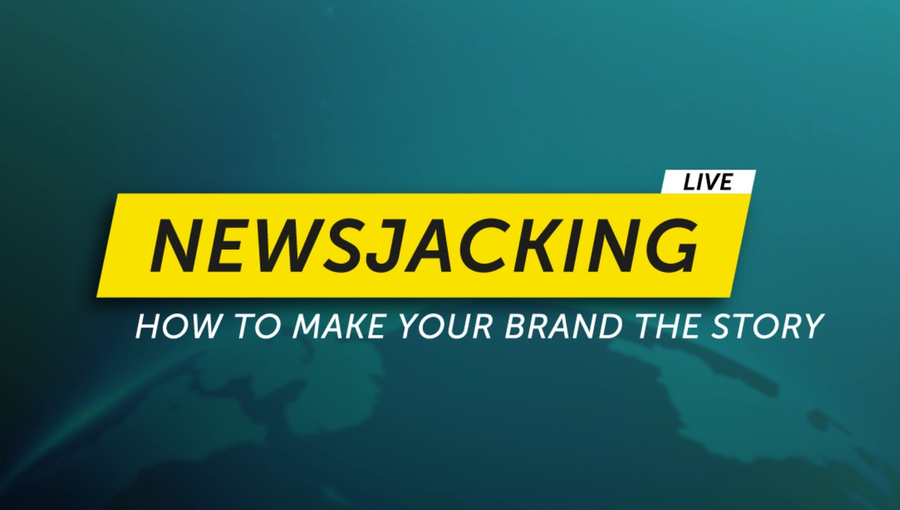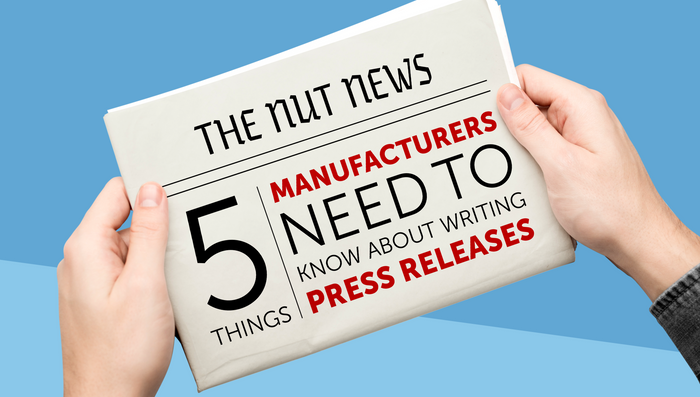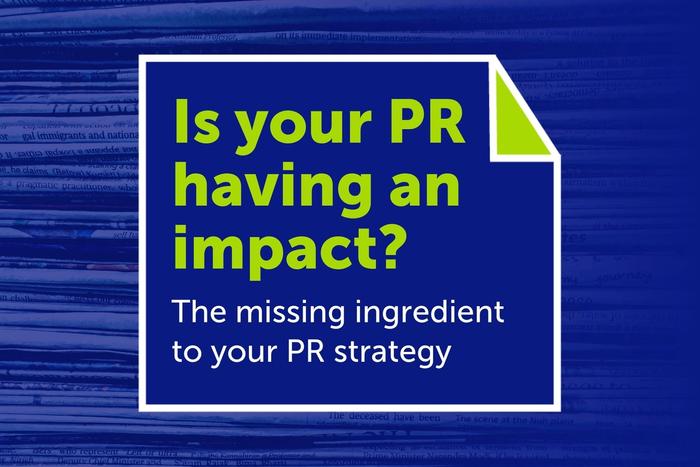PR
The 3 Pillars of Strategic Newsjacking: Lessons from Risky PR Stunts and Epic Fails
Every brand wants that viral moment the perfectly timed, clever post that rides a news cycle to millions of impressions. But for every Oreo in the dark, there are ten other brands that are late, insensitive, or just plain irrelevant.
We call this practice newsjacking. The difference between a massive PR win and a reputation-damaging gaffe isn't luck; it's a tight strategic framework built on speed and precision. This is how the masters consistently pull it off, and how your team can avoid the costly, embarrassing failures.
The 3-Pillar Newsjacking Framework
Successful reactive content isn't a chaotic sprint; it's the result of rigorously evaluating an opportunity against three non-negotiable pillars: Relevance, Timing, and Courage.
Pillar 1: relevance (the brand-to-news connection)
The fundamental question is not "Can we join this conversation?" but "Should we?" The best newsjacks feel like the only brand that could have made that comment. They are an organic extension of the brand's voice and product.
The test we recommend is seeing if there is an authentic, organic, and believable connection between the news and your brand's core product, service, or values?
We first see this in the Oreo case study for Super Bowl XLVII Power Outage (2013). A blackout is the absence of light. An Oreo dunked in milk is the absence of light. The image works without a caption. It had high relevance where the absence of light tied directly to the product's function.
The second case study for KitKat where the brand tapped into reports of the new iPhone 6 models bending easily (Bendgate, 2014). Sticking with their tagline "Have a Break" provided good humour, the joke is simple, appropriate, and on-brand. It had high relevance a classic pun tied directly to the brand’s long-standing message.
Pillar 2: timing (the news cycle window)
News moves in a curve. If you post too early, no one knows what you’re talking about. If you post too late, you are simply adding noise to yesterday's story. The ideal window is narrow just as the news is breaking and accelerating.
The test we recommend is to see if you are adding your comment while the news story is still accelerating, but before the conversation has peaked and the media is simply summarising it?
David Meerman Scott, who coined the term, places the optimal time in the hours right after the news breaks but before journalists have moved on to the next development. Miss this window, and your genius post becomes irrelevant content.
Pillar 3: courage (the internal sign-off)
Speed is often the most difficult part of newsjacking because it requires marketing teams to bypass the standard, multi-stage approval process. When the optimal window is 45 minutes, a three-day internal sign-off process is a fatal flaw.
The test we recommend is to see if your internal process allow for a rapid, delegated sign-off (ideally under 15 minutes) to execute an authentic, non-generic post that matches the speed of the news cycle?
However, its important to consider that the most clever reactive ideas often die on the desk of an overly cautious legal or compliance department. Success requires a proactive agreement to tolerate a measured amount of risk.
The newsjacking evaluation matrix: Good, Bad, and Pointless
To truly understand newsjacking, we must look at the spectrum of outcomes that go beyond just "Success" and "Failure." Most attempts fall into the frustrating third category.
The good: the home Run using high relevance, high timing and high courage
A "Good" newsjack amplifies the brand's core message while capitalising on an authentic opportunity.
Oreo's The Blackout tweet. The post was simple, visually perfect, perfectly timed (within minutes), and instantly associated the brand with a major cultural moment. It was a rapid, confident execution of a relevant idea.
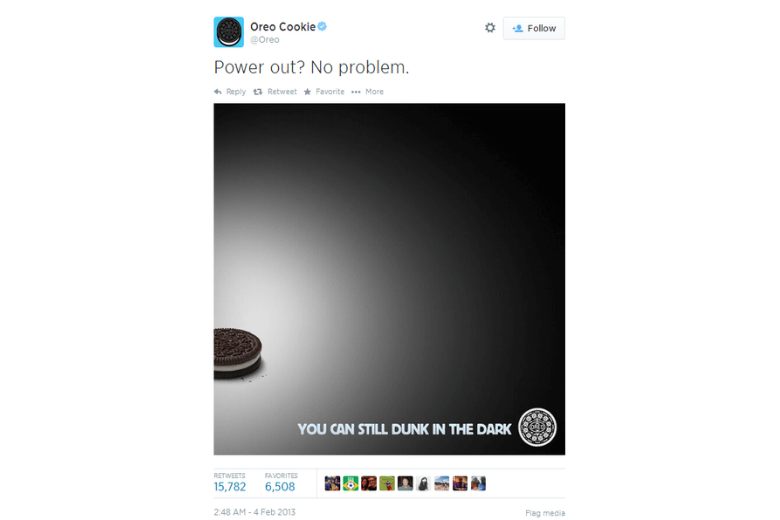
That was Oreo’s tweet in response to the power cut at the 2013 Superbowl. The power cut lasted 45 minutes. Once it was fixed, sending a tweet like that would be basically pointless.
Also, it speaks to the power of timing, because the link is tenuous at best. It doesn’t score relevance points. People know enough about the process of social media marketing that the turnaround time was impressive. Context beats content here.
One very important thing to remember was that Oreo had an advertising slot for the Superbowl already. They already had a social media team assembled, ready to respond to the event and the social chatter from their ad. Crucially, they had people with them who had sign-off on any posts.
Responding to news ‘in the wild’ will never be as slick as that, but it illustrates the power of a timely contribution.
The bad: the reputation killer with low relevance, high timing, and low courage
A "Bad" newsjack is typically a tone-deaf, opportunistic attempt to insert a brand into a tragedy, a major political event, or a sensitive cultural moment without any genuine tie.
A Gaps’s tweet during Hurricane Sandy that was quickly deleted after it was perceived as leveraging a natural disaster to drive store traffic. The team was fast (High Timing), but the complete lack of empathy and zero product-to-event relevance made it toxic. The lesson to take away is to never newsjack a tragedy. Speed without sensitivity is recklessness.

Meerman Scott places the ideal newsjacking point here:
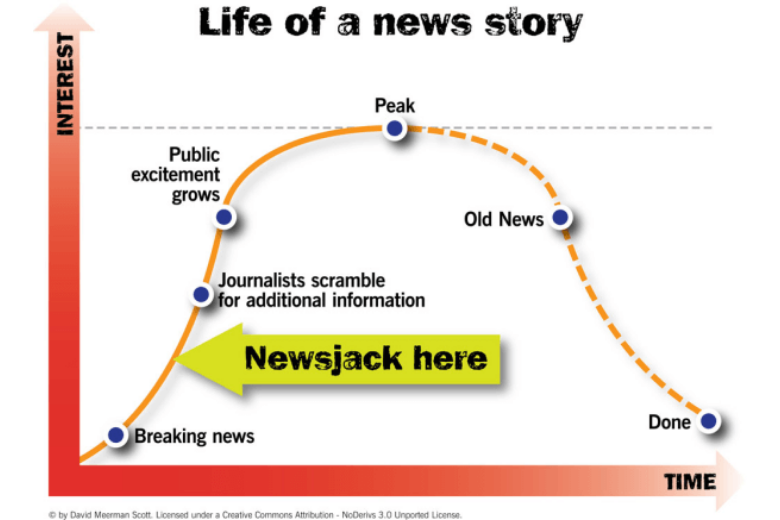
For maximum impact, you want your post to get out there when the story is taking off and still gaining momentum. You won’t just be commenting on the story, you’ll be part of it.
When something truly viral is happening, you can guarantee that lots of brands are going to jump on it. It’s good to do it first, of course. You don’t want to be drowned out. At the same time, if you’re not first, doing it best will differentiate you.
The pointless: the wasted effort with low timing, medium relevance and low courage
The "Pointless" attempts are the most common and damaging in the long run, leading to burnout and frustration. They waste resources without generating any positive attention.
Cinnabon’s Carrie Fisher Tweet. Following the death of actress Carrie Fisher, Cinnabon tweeted a tribute to the star, noting that she would "have the best buns in the galaxy." While arguably related to the product (buns), the timing was inappropriate, and the effort to sell cinnamon rolls off a celebrity’s death was widely criticized as crass. The lesson to take away is that the low ourage (in the sense of being willing to pass) and poor Relevance means no one wins.
It was in very poor taste and a PR disaster, but at least Cinnabon’s Carrie Fisher tweet had some internal logic. Her most famous character was known for a hairstyle resembling cinnamon buns.
Even if it was negative, they got some attention. If you attempt to force your brand into a story that it doesn’t fit, you’ll probably get no engagement at all.
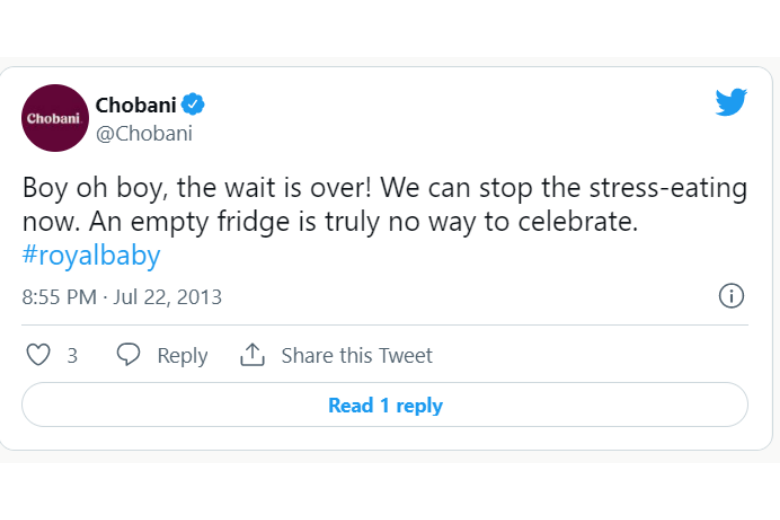
Via classy.org
Chobani is a US-based yoghurt company. It was a big stretch for it to newsjack the birth of Prince George, and that tweet didn’t even make much sense. It got ignored. It was a waste of time, and something like that risks muddying the water of your brand. A half-baked newsjack rubs against whatever curated marketing and branding you’ve invested in so far.
Newsjacking tips
Newsjacking is a little like alchemy. You’re trying to make gold, you don’t know exactly what you need to do, and it could blow up in your face.
Here are some safety tips:
- Don’t newsjack for the sake of it. If the relevance of a news story to your brand is tenuous, you can do more harm than good
- When the time is right, seize the moment. Newsjack in a timely fashion, and make the message clear.
- Don’t newsjack tragedy
The 1-minute summary of newsjacking
Newsjacking success is defined by a balanced alignment of three core pillars. Before the clock runs out on any trend, you must meet these criteria:
Pillar 1: Relevance
- What to test for: Is there an authentic, organic, and believable connection between the news and your brand's core product, service, or values?
- The warning you should consider: Avoid forcing a connection to a tragic or sensitive event, as this is the fastest way to look opportunistic.
Pillar 2: Timing
- What to test for: Are you adding your comment while the news story is still accelerating, but before the conversation has peaked and the media is simply summarizing it?
- The warning you should consider: Being late makes your post feel like a dull echo. Speed is your competitive advantage.
Pillar 3: Courage
- What to test for: Does your internal process allow for a rapid, delegated sign-off (ideally under 15 minutes) to execute an authentic, non-generic post that matches the speed of the news cycle?
- The warning you should consider: A slow, committee-driven approval process is where most powerful newsjacking attempts die.
The newsjacking checklist: how to turning a trend into a post in under an hour
The most powerful factor you can control is the speed of your internal process. To successfully execute a fast-moving reactive PR stunt, you must operationalise the "Courage" pillar.
Step 1. the spot and vet (5 Minutes)
Your team needs constant, real-time monitoring and a universal filter. Set up a dedicated monitoring system (e.g., Google Alerts, X trending topics, Slack feeds) for industry keywords, competitor names, and high-visibility, neutral events (sports, technology).
A single person (the designated newsjacker) must run every opportunity through this rapid-fire ethical and strategic check:
- Does your brand Fit? If we remove the brand name, does the comment still make sense? (If the answer is no, the relevance is high.)
- Is there a sensitivity risk? Is anyone experiencing genuine hardship or tragedy due to this news? (If the answer is yes, stop and pass.)
- Can you or would you be adding value? Does our comment offer unique insight, a clever joke, or a new perspective? (If the answer is no, it will be pointless noise.)
Step 2. the delegated sign-off authority (10 minutes)
Forget the standard five-step approval chain. Speed requires trust and preparation.
Have pre-approved guidelines in place. Before any news breaks, your legal and leadership teams must pre-approve the boundaries of reactive social content. This includes: approved tonality (e.g., 'playful satire' is okay, 'divisive commentary' is not), restricted topics (e.g., politics, tragedy), and maximum exposure limits (e.g., a simple social media post is fine; a full press release requires a second sign-off).
Designate a Newsjacking Czar. Assign one, and only one, person or a very small, rotating team the authority to hit "send" on social content that falls within the pre-approved boundaries. This person is empowered to make a fast decision and must be trusted with the brand voice.
3. The Hook and Delivery (45 Minutes)
Once approved, every second counts.
Prioritise visuals with fast, custom-made visuals (a simple graphic, a quick photo, or a meme) that cut through text noise better than any wordplay. Oreo’s success was 80% visual execution.
Focus on the unique angle specific to your brand. Do not simply repeat the news. Deliver your unique, concise insight. If the first thing people read is what they already know, they will scroll past.
Your Brand is Not a Reaction Machine
Newsjacking, or reactive PR, is a high-risk, high-reward tactic that rewards preparation, not improvisation.
By building a framework that rigorously tests an opportunity's Relevance and pinpoints the narrow window of Timing, you empower your team to act with Courage. This process forces your brand to be more selective, ensuring that the next time you jump into the global conversation, you're doing it with purpose, precision, and an authentic voice. Your goal is not to react to every story, but to become an unmissable part of the perfect one.
Share this:
